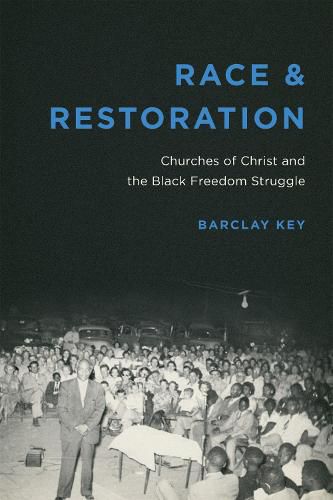Readings Newsletter
Become a Readings Member to make your shopping experience even easier.
Sign in or sign up for free!
You’re not far away from qualifying for FREE standard shipping within Australia
You’ve qualified for FREE standard shipping within Australia
The cart is loading…






This title is printed to order. This book may have been self-published. If so, we cannot guarantee the quality of the content. In the main most books will have gone through the editing process however some may not. We therefore suggest that you be aware of this before ordering this book. If in doubt check either the author or publisher’s details as we are unable to accept any returns unless they are faulty. Please contact us if you have any questions.
From the late nineteenth century to the dawn of the civil rights era, the Churches of Christ operated outside of conventional racial customs. Many of their congregations, even deep in the South, counted whites and blacks among their numbers. As the civil rights movement began to challenge pervasive social views about race, Church of Christ leaders and congregants found themselves in the midst of turmoil. In Race and Restoration: Churches of Christ and the Black Freedom Struggle, Barclay Key focuses on how these churches managed race relations during the Jim Crow era and how they adapted to the dramatic changes of the 1960s.
Although most religious organisations grappled with changing attitudes toward race, the Churches of Christ had singular struggles. Fundamentally
restorationist,
these exclusionary churches perceived themselves as the only authentic expression of Christianity, compelling them to embrace peoples of different races, even as they succumbed to prevailing racial attitudes. The Churches of Christ thus offer a unique perspective for observing how Christian fellowship and human equality intersected during the civil rights era. Key reveals how racial attitudes and practices within individual congregations elude the simple categorizations often employed by historians. Public forums, designed by churches to bridge racial divides, offered insight into the minds of members while revealing the limited progress made by individual churches.
Although the Churches of Christ did have a more racially diverse composition than many other denominations in the Jim Crow era, Key shows that their members were subject to many of the same aversions, prejudices, and fears of other churches of the time. Ironically, the tentative biracial relationships that had formed within and between congregations prior to World War II began to dissolve as leading voices of the civil rights movement prioritised desegregation.
$9.00 standard shipping within Australia
FREE standard shipping within Australia for orders over $100.00
Express & International shipping calculated at checkout
This title is printed to order. This book may have been self-published. If so, we cannot guarantee the quality of the content. In the main most books will have gone through the editing process however some may not. We therefore suggest that you be aware of this before ordering this book. If in doubt check either the author or publisher’s details as we are unable to accept any returns unless they are faulty. Please contact us if you have any questions.
From the late nineteenth century to the dawn of the civil rights era, the Churches of Christ operated outside of conventional racial customs. Many of their congregations, even deep in the South, counted whites and blacks among their numbers. As the civil rights movement began to challenge pervasive social views about race, Church of Christ leaders and congregants found themselves in the midst of turmoil. In Race and Restoration: Churches of Christ and the Black Freedom Struggle, Barclay Key focuses on how these churches managed race relations during the Jim Crow era and how they adapted to the dramatic changes of the 1960s.
Although most religious organisations grappled with changing attitudes toward race, the Churches of Christ had singular struggles. Fundamentally
restorationist,
these exclusionary churches perceived themselves as the only authentic expression of Christianity, compelling them to embrace peoples of different races, even as they succumbed to prevailing racial attitudes. The Churches of Christ thus offer a unique perspective for observing how Christian fellowship and human equality intersected during the civil rights era. Key reveals how racial attitudes and practices within individual congregations elude the simple categorizations often employed by historians. Public forums, designed by churches to bridge racial divides, offered insight into the minds of members while revealing the limited progress made by individual churches.
Although the Churches of Christ did have a more racially diverse composition than many other denominations in the Jim Crow era, Key shows that their members were subject to many of the same aversions, prejudices, and fears of other churches of the time. Ironically, the tentative biracial relationships that had formed within and between congregations prior to World War II began to dissolve as leading voices of the civil rights movement prioritised desegregation.